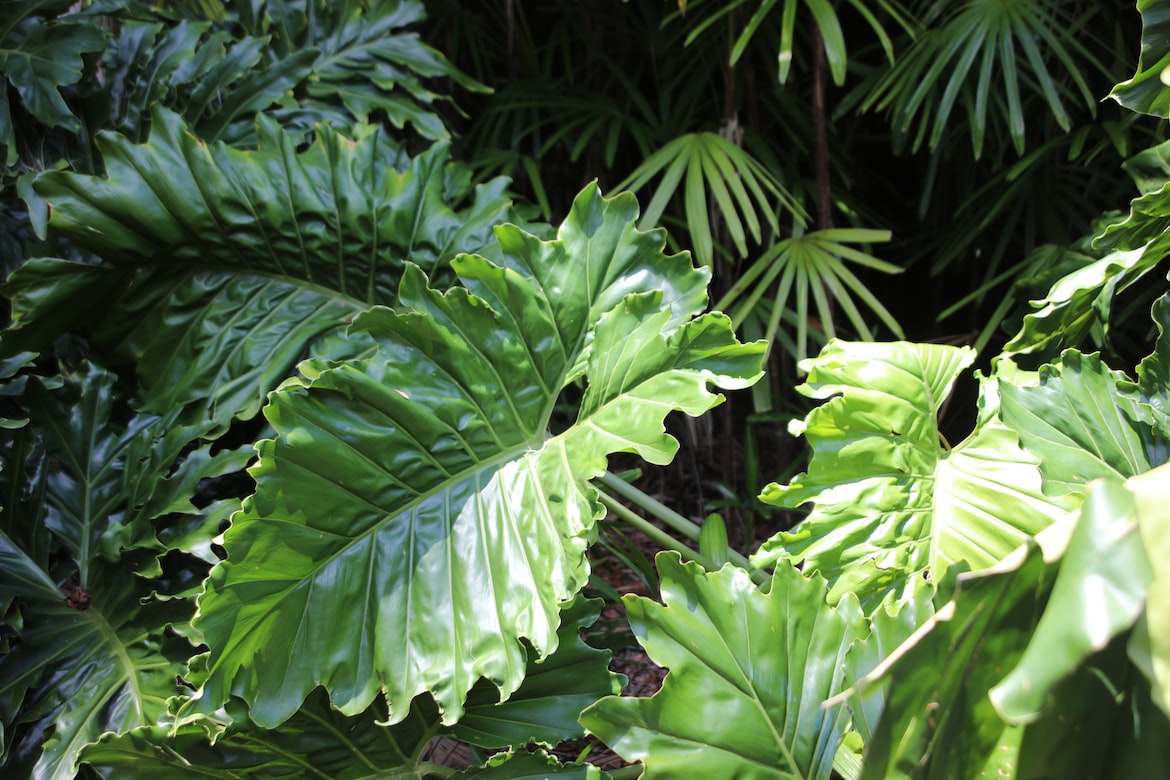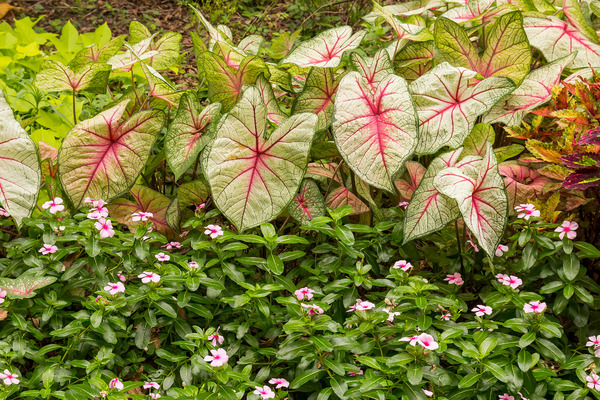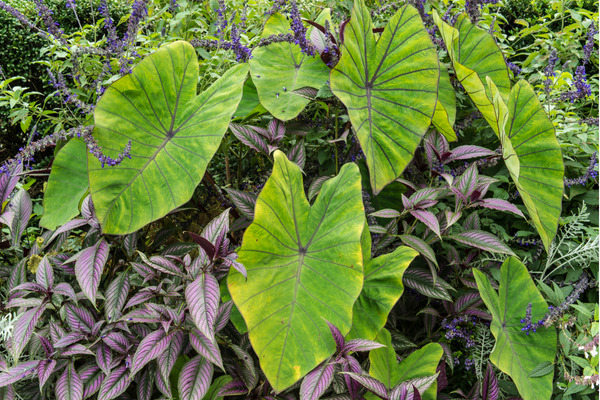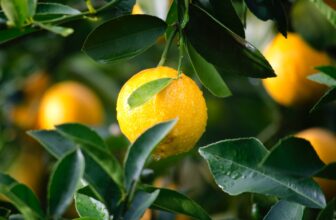
Table of Contents
Elephant ear (Colocasia, Alocasia, and Xanthosoma) is a tuberous, perennial originating from tropical Asia that needs a moist climate and filtered sun to grow to its best. It adds a tropical look that’s bold and ornamental, adding a focal point of lush foliage to your surroundings.
These plants have enormous heart-shaped leaves that resemble the ears of an elephant. In some cultures, the elephant’s ear symbolizes wisdom, strength, and protection.
They make great background plants, and you can use them as ground covers and edgings. Elephant ears can be toxic, yet they have medicinal and air-purifying qualities that are beneficial.

They make great indoor and outdoor plants as long as there is enough light and water. If you are growing an elephant ear plant at home, then provide it with a tropical climate; don’t let it dry out. During the hot summer months, it should have regular moisture.
The leaves can grow to lengths of 3 feet and the stems can grow to 3 to 7 feet with a color anywhere from lime green to almost black and they have prominent veins.
If you would like to add a tropical bold statement of luxurious foliage to your garden spaces, we have covered the key facts you would need to know and how you can grow and care for elephant ear plants.
Most Popular Types of Elephant Ears

- Blue Hawaii (Colocasia esculenta): It has medium green leaves with maroon undersides and dark purple-black veins.
- Black Magic (Colocasia esculenta): It has dusty purple-black leaves that slightly fold upwards.
- Lime Zinger (Xanthosoma aurea): These plants feature brilliant chartreuse green leaves.
- Coffee Cups (Colocasia esculenta): This robust hybrid variety of elephant ear plants has smaller leaves, folding upwards to form a cup shape.
- Mojito (Colocasia esculenta): The leaves of this variety are dull green and are flecked irregularly, with streaks of black and speckled.
- Illustris (Colocasia esculenta): This variety is different from the other varieties of elephant ears as it propagates through underground runners instead of tubers or corms. These plants have dark green matte leaves featuring bright green veins.
How To Care For Elephant Ear Plants

Here are some tips on how to grow and maintain your elephant ear plants.
Planting Tips
Elephant ears grow from tubers, which are buried in the soil after the last winter frost. If your area becomes too cold in the winter, then it is good to dig out the tubers during the winter and replant them again in the spring. Here are some tips when growing elephant ear plants:
- Plant the elephant ears in a place where it gets part shade or filtered sun and the soil remains wet. Elephant ears do not grow well in dry soil and full sun.
- Heavy gusts of wind can damage the huge leaves. So, keep them safe from strong winds.
- Make the soil ready by adding compost or aged manure before planting the tubers.
- Bury the tuber in a hole 2-4 times bigger than itself and 1-2 inches below the soil.
- Always try to plant the tubers close to the surface.
- You can grow elephant ears in the standing water of a pond, or water gardens, which are up to 6’’ deep.
- If you are planting elephant ears indoors, use a large pot, as the plant can become monstrous.
Light Requirements
When growing outdoors, choose a place where it would receive partial shade. While for indoor settings, it would need bright sunlight which is not too hot. If the leaves look brown and bleached, then move the plant to a place with lesser sunlight or add a shade or some form of the curtain to block the direct sunlight.
Fertilizers
Use an all-purpose liquid fertilizer every couple of weeks and don’t apply fertilizer during the winter months so that the plant can rest.
Watering Needs
Keep the soil moist, but don’t overwater to make it soggy. If the pot you are growing the plant in does not have drainage holes, then water the plant with extra care. You may check the soil from time to time to know if it’s too dry or too wet for the plant to grow properly.
To keep the plant in humid circumstances, it is a good idea to use pebbles to elevate the pot over a saucer of water. This way, the plant will have enough humidity and the roots will be saved from rotting due to excessive water.
Toxicity
Oxalic acid crystals are present in the leaves and stem of the elephant ear plant, which is toxic to both humans as well as pets and results in the following when touched or consumed:
- Skin irritation
- Swelling of lips, mouth, and throat
- Committing
Nevertheless, in many countries of Asia, colocasia is eaten, as they become harmless by cooking down the crystals.
Dormancy Period and What to Do
Elephant ear plants go for a winter slumber when the plant stops growing, and the leaves turn brown and fall off. Just stop watering the plant till it starts growing back in the spring. If the temperature isn’t cold enough for the plant to go into dormancy, then still reduce watering the plant in winter.
Pests
Commonly, elephant ear plants are affected by the following pests:
- Whiteflies
- Spider Mites
- Aphids, mealybugs
Wash these pests off the leaves and apply a horticultural soap or spray a soapy solution.
Common Problems with Elephant Ear Plants

Even though elephant ears can be grown easily, and are fast growers, they still face some problems while growing. As the most prominent feature of these plants is their huge leaves, these leaves face most of the issues. Let’s look at the problems that elephant ears may have and what can be done.
1. Yellow Leaves
When the plant doesn’t receive the right amount of sunlight, fertilizer, or water, then its leaves start to turn yellow. Another reason could be that the plant is in its dormancy. You may try adjusting the watering, sunlight, and fertilizer, and cutting the yellow leaves.
2. Drooping leaves
Cold temperatures can make the leaves droop as well as if the plant doesn’t receive the right amount of light, fertilizer, or water. The large leaves start to droop if they cannot hold their own weight. So, give support to the plant and adjust the light, temperature, and water.
3. Wilting Leaves
Too much heat exposure and not enough water can make the leaves wilt. So, move the plant to a place where it receives less sunlight and regularly water the plant.
4. Pale leaves
Leaves of elephant ears start to lose their color and become pale and deformed, indicating the plant needs lighter, nutrients, and water. Move your plant to a place where it gets less sunlight and more water and add fertilizers.
Wrapping Up
Elephant Ear plants add beauty and foliage to a dull environment with their huge, heart-shaped leaves. They make great indoor and outdoor plants. Now that you know how to grow and care for elephant ears, this might be a great choice to try out.
Remember to follow the care tips for planting and growing elephant ears, and your plant will grow to add that tropical splendor to your home surroundings.
FAQs
1. Does this plant need a lot of Sun to grow well?
Elephant Ear plants grow best in places with dappled shade and moist, warm, and humid environments. It is good to grow them next to a fence or wall to avoid getting the leaves burned by too much sun.
2. How much water do they need to grow properly?
You should not overwater the plant to make the soil soggy and the roots musty and rotten. But, remember to never let the soil dry out. You may need to water it every day or even more than once during the same day.
3. What proper care do these plants need in the winter season?
It depends on the place and climate you live in. Elephant ears cannot survive frost. So, if you have frost in your region, then dig out the tubers from the soil before any frost and let them dry in a dry and warm location for 1-2 weeks before you save them for the next planting.
But in the warmer regions, the elephant ear plant goes into a dormancy period, where it sheds its leaves and stops growing during the winter.
If you remove the tubers and save them, then the best time to plant them again is in early spring.
4. How to remove and store the tuber?
If you live in a colder region, then dig up the tubers before the temperature goes below 40 F, to replant them in the spring. Start digging from about a foot from the plant’s center, lift the plant out and let the root ball dry.
Then cut back the stems and store the tubers in open containers to keep them dry and prevent them from rotting. The best place to store the tubers is in a potting shed or a garage, placed inside a container made with sawdust, peat moss, or vermiculite.
5. What Medicinal benefits do elephant ear plants have?
The leaves of the elephant ear plant can be used as a poultice on infected sores. The stem leaf can be used to treat insect stings to prevent swelling from the bite.
6. Are elephant ear plants toxic to pets and humans?
As the plant contains asparagine and oxalic acid, which is a type of protein when eaten, it can cause skin reactions, swelling, diarrhea, nausea, mouth, and throat burns, and vomiting.
7. Are elephant ear plants good for air purifying?
With their large heart-shaped leaves, elephant ears can produce more oxygen. They also remove formaldehyde from the air which is great for your indoors.






